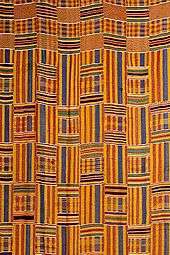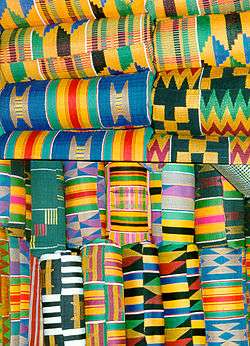Kente cloth

Kente, known as nwentom in Akan, is a type of silk and cotton fabric made of interwoven cloth strips and is native to the Akan ethnic group of West Ghana. Kente is made in Akan lands such as Ashanti Kingdom, (Bonwire, Adanwomase, Sakora Wonoo, Ntonso in the Kwabre areas of the Ashanti Region) It is also worn by the south eastern, central, and the northern people of Ghana. Kente comes from the word kenten, which means basket in Akan dialect Asante. Akans refer to kente as nwentoma, meaning woven cloth. It is an Akan royal and sacred cloth worn only in times of extreme importance and was the cloth of kings. Over time, the use of kente became more widespread. However, its importance has remained and it is held in high esteem with Akans.
Characteristics
Kente characterized by weft designs woven into every available block of plain weave is called adweneasa. The Akan people choose kente cloths as much for their names as their colors and patterns. Although the cloths are identified primarily by the patterns found in the lengthwise (warp) threads, there is often little correlation between appearance and name. Names are derived from several sources, including proverbs, historical events, important chiefs, queen mothers, and plants.The cloth symbolizes high in value.
Origins
West Africa has had a cloth weaving culture for centuries via the stripweave method, but Akan history tells of the cloth being created independent of outsider influence. Kente cloth has its origin from the Akan-Ashanti kingdoms in Ghana. The origin of kente is in the Akan empire of Bonoman. Most Akans migrated out of the area that was Bonoman to create various states.[1] The Ewe people of Ghana think the weaving of Kente originates with them, although they are not claiming they invented the art of weaving. They suggest that the name is derived from Kete which relates to the two alternating rhythmic actions (ke and te, meaning open and press in the Ewe language) associated with the weaving of the loom.
Symbolic meanings of the colors
- black: maturation, intensified spiritual energy
- blue: peacefulness, harmony and love
- green: vegetation, planting, harvesting, growth, spiritual renewal
- gold: royalty, wealth, high status, glory, spiritual purity
- grey: healing and cleansing rituals; associated with ash
- maroon: the color of mother earth; associated with healing
- pink: assoc. with the female essence of life; a mild, gentle aspect of red
- purple: assoc. with feminine aspects of life; usually worn by women
- red: political and spiritual moods; bloodshed; sacrificial rites and death.
- silver: serenity, purity, joy; associated with the moon
- white: purification, sanctification rites and festive occasions
- yellow: preciousness, royalty, wealth, fertility, beauty
Traditions
A variety of kente patterns have been invented, each of which has a certain concept or concepts traditionally associated with it.[3] For example, the Obaakofoo Mmu Man pattern symbolizes democratic rule; Emaa Da, novel creativity and knowledge from experience; and Sika Fre Mogya, responsibility to share monetary success with one's relations.[4]
Legend has it that kente was first made by two Akan friends who went hunting in an Asanteman forest found a spider making its web.[5] The friends stood and watched the spider for two days then returned home and implemented what they had seen.
Modern use of kente

Kente academic stoles are often used by African Americans as a symbol of ethnic pride.[6][7][8] This practice is also very popular with historically black Greek letter fraternities and sororities. African American students hold special ceremonies called "Donning of the Kente" where the stoles are presented to the graduates.
References
- ↑ Kwasi Konadu, Kwasi Konadu, Indigenous medicine and knowledge in African society, Routledge, 2007. pp. 30–31.
- ↑ Kente Cloth Archived 2009-01-06 at the Wayback Machine.." African Journey. projectexploration.org. 25 Sep 2007.
- ↑ Wisdom: Adinkra Symbols & Meanings. welltempered.net.
- ↑ G. F. Kojo Arthur and Robert Rowe (2001). "Akan Kente Cloths and Motifs". Akan Cultural Symbols Project. Marshall University. Archived from the original on 2010-01-07. Retrieved 2011-10-15.
- ↑ West African Wisdom: Adinkra Symbols & Meanings – Bibliography
- ↑ Lynch, Annette; Strauss, Mitchell D. (2014). Ethnic Dress in the United States: A Cultural Encyclopedia. Rowman & Littlefield. p. 176. ISBN 9780759121508.
- ↑ Matory, J. Lorand (2015). Stigma and Culture: Last-Place Anxiety in Black America. University of Chicago Press. p. 134. ISBN 9780226297736.
- ↑ Boateng, Boatema (2011). The Copyright Thing Doesn't Work Here: Adinkra and Kente Cloth and Intellectual Property in Ghana. University of Minnesota Press. p. 140. ISBN 9780816670024.



.svg.png)